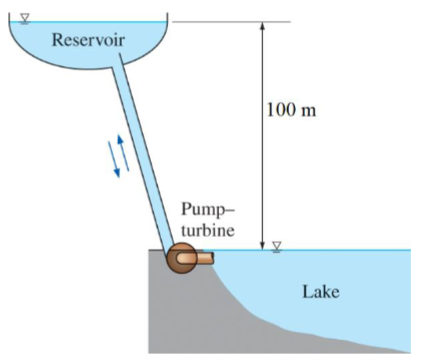The demand for electric power is usually much higher during the day than it is at night, and utility companies often sell power at night at much lower prices to encourage consumers to use the available power generation capacity and to avoid building new expensive power plants that will be used only a short time during peak periods. Utilities are also willing to purchase power produced during the day from private parties at a high price. Suppose a utility company is selling electric power for $0.07/kWh at night and is willing to pay $0.15/kWh for power produced during the day. To take advantage of this opportunity, an entrepreneur is considering building a large reservoir 100 m above the lake level, pumping water from the lake to the reservoir at night using cheap power, and letting the water flow from the reservoir back to the lake during the day, producing power as the pump–motor operates as a turbine–generator during reverse flow. Preliminary analysis shows that a water flow rate of 2.5 m3/s can be used in either direction, and the irreversible head loss of the piping system is 5 m. The combined pump– motor and turbine–generator efficiencies are expected to be 80% each. Assuming the system operates for 10 h each in the pump and turbine modes during a typical day, determine the following: (a) The total theoretical power generation capacity of the reservoir (kW) (b) The total electrical power generation capacity of the reservoir (kW) (c) The potential revenue of this pump–turbine system can generate per year ($/year)
Problem 8
The demand for electric power is usually much higher during the day than it is at night, and
utility companies often sell power at night at much lower prices to encourage consumers to use
the available power generation capacity and to avoid building new expensive power plants that
will be used only a short time during peak periods. Utilities are also willing to purchase power
produced during the day from private parties at a high price.
Suppose a utility company is selling electric power for $0.07/kWh at night and is willing to pay $0.15/kWh for power produced during the day. To take advantage of this opportunity, an entrepreneur is considering building a large reservoir 100 m above the lake level, pumping water from the lake to the reservoir at night using cheap power, and letting the water flow from the reservoir back to the lake during the day, producing power as the pump–motor operates as a turbine–generator during reverse flow. Preliminary analysis shows that a water flow rate of 2.5 m3/s can be used in either direction, and the irreversible head loss of the piping system is 5 m. The combined pump–
motor and turbine–generator efficiencies are expected to be 80% each.
Assuming the system operates for 10 h each in the pump and turbine modes during a typical day, determine the
following:
(a) The total theoretical power generation capacity of the reservoir (kW)
(b) The total electrical power generation capacity of the reservoir (kW)
(c) The potential revenue of this pump–turbine system can generate per year ($/year)

Trending now
This is a popular solution!
Step by step
Solved in 6 steps




